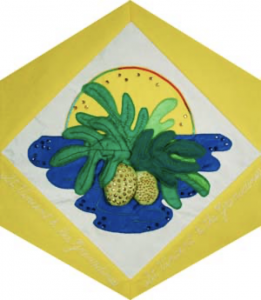Saint Vincent and the Grenadines

The Block
The featured element of this block, a plump, ripe breadfruit was chosen by blockmaker Cynthia Murray for its role as a living part of the islands’ history and for its place as a dietary staple. The HMS Bounty’s Captain William Bligh brought the first breadfruit trees to Saint Vincent and the Grenadines in 1793. He planted them in the Botanical Gardens, the oldest in the Western Hemisphere, where a descendant of the original trees still thrives. Fruit of these trees have the consistency of potatoes and were once looked upon as an excellent food source for slaves. Today breadfruit, paired with jackfish, is the islands’ national dish.
On the block, which encompasses national colours, an undulating pattern of silk leaves surrounds the sequined-covered breadfruit to evoke the carnival feel of Vincy Mas––Saint Vincent’s main cultural event of the year––in which elaborately costumed participants fill the streets. The vibrant green symbolizes the islands’s lush vegetation while the silky blue of the background represents both the sky and the gentle waters of the ocean and sea. The yellow reflects not only the warmth of the sun but the warmth and bright spirit of the people as well.
Cultural Profile
The nation of Saint Vincent and the Grenadines is comprised of the island of Saint Vincent, the most populated island, and the northern Grenadine Islands. These are about 30 small islands, less than a dozen of which are inhabited. Located in the Caribbean, the country is the world’s largest producer of arrowroot and was once renowned for its sugar plantations. Today the main export is bananas and although many families make their living operating banana farms, the livelihood of most people is dependent upon the sea. The official language is English, but for everyday use most Vincentians speak a local Creole dialect called ‘Vincy’ English.
Saint Vincent and the Grenadines were originally inhabited by indigenous Caribs that prevented European settlement until 1719. They were joined by Africans who had escaped slavery in neighboring islands. The Africans intermarried with the Caribs and their descendants were later called Black Caribs or Garifuna. Some of them were later deported to the island of Roatan, giving rise to the Garifuna ethnic groups of Honduras and Belize, amongst others. Vincentian culture also evidences French and British influences.
Vincentians have a strong storytelling tradition and exchanging folk tales, news and memories is an integral part of community life. Storytelling abilities and confident conversational styles are important aspects of education, believed by many to reflect an individual’s strength and intelligence. Music is also important on the islands and includes styles such as Big Drum, Calypso and Reggae. Carnival, known locally as ‘Vincy Mas,’ is the country’s largest annual event. It includes concerts, street parties, and parades in which many dancers wear enormous gauze-covered wire wings and elaborate headdresses.
Boat launches are another important social event on the Grenadines and many Vincentians are expert boat builders who construct some of the Caribbean’s finest sailing boats. Artisans also create wooden models of schooners and whale boats made exactly to scale, painted in traditional colours and outfitted with sails and rigging. Leatherwork and pottery are also done in the country.
Vincentians coming to Canada settled mainly in Ontario. As with other Caribbean nations, they have influenced this country in many ways, most noticeably through the introduction of calypso music and Carnival. The 2011 census reports that there are now over 14,000 Vincentians living in Canada.
Sponsor: Russell Village Women’s Institute
